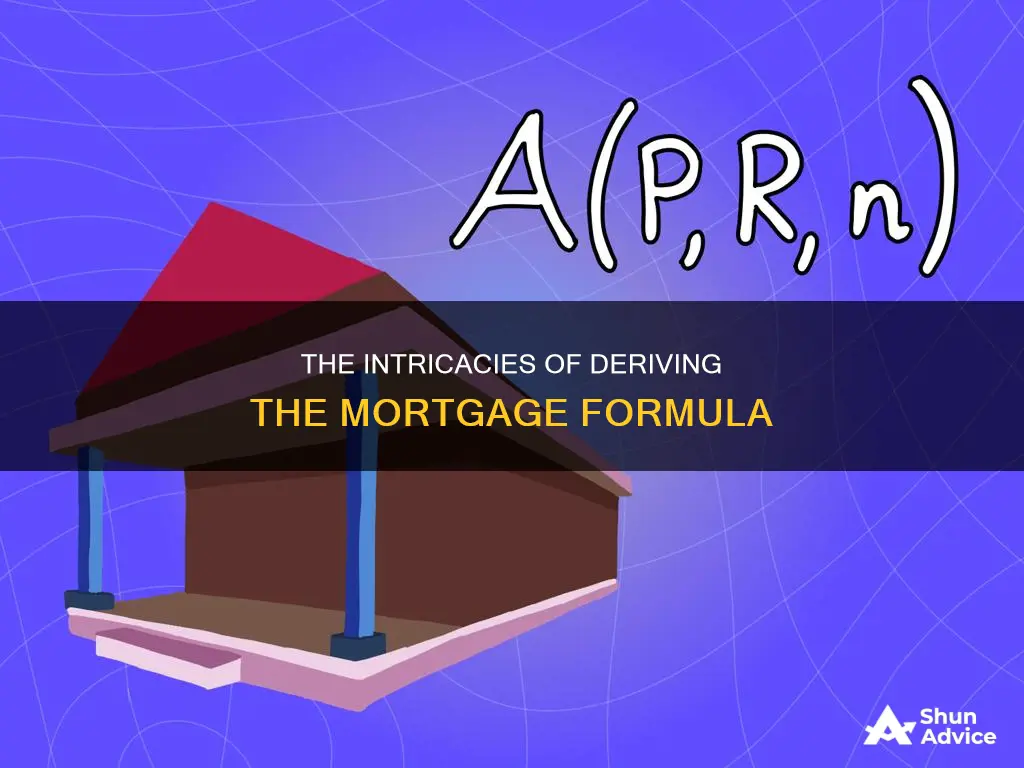
The mortgage formula is a complex calculation that helps individuals determine their monthly mortgage payments. It takes into account various factors, including the loan principal, interest rate, loan term, and down payment. By inputting these variables into the formula, individuals can gain a clearer understanding of their financial commitments and make informed decisions about their property purchases. This formula is the foundation for mortgage calculators, which are widely used by consumers and lenders to assess financial suitability for home loans.
| Characteristics | Values |
|---|---|
| Variables | P = Principal amount, i = Interest rate, n = Number of payments, M = Monthly payment |
| Formula Derivation | M = PJ / [ 1 - (1 + J) -N ] |
| Amortization Loan | A fixed amount paid monthly to pay off the debt and interest by the end of the loan term |
| Monthly Payment | Depends on the loan amount, interest rate, and the number of payments |
| Mortgage Calculators | Automated tools to determine monthly repayments and financial suitability of applicants |
| Additional Costs | Property taxes, insurance, HOA fees, utilities, home maintenance, etc. |
What You'll Learn

Amortization schedules
An amortization schedule is a table that provides details of a loan and its payments, specifically for a reducing term loan. It outlines how a loan is paid down over time, and is particularly relevant for mortgages. It is a powerful tool for budgeting and transparency, allowing borrowers to understand the repayment structure of their loan.
The schedule will show the original loan amount, the loan balance at each payment, the interest rate, the amortization period, the total payment amount, and the proportion of each payment that is interest and principal. It will also indicate the interest paid to date, the principal paid to date, and the remaining principal balance on each payment date.
The schedule is usually presented as a chronological table, with the first payment assumed to take place one full payment period after the loan was taken out. Each payment will consist of an interest payment and a principal payment. The interest payment goes towards the interest accrued on the loan, while the principal payment contributes to the actual debt.
The interest portion is larger at the beginning of the loan term, due to the higher loan balance. Over time, as the debt goes down, the interest reduces, and the principal payment increases. This means that more money can be put towards reducing the underlying debt. This is reflected in the amortization schedule, which shows how the proportion of each payment attributed to interest and principal changes over time.
Mortgage Pre-Approval: Essential Step for Home Loan Success
You may want to see also

Monthly payments
When taking out a mortgage, it is important to understand the monthly payments you will be expected to make. These payments are made up of interest and principal payments. The interest payment goes towards the interest charged by the bank for borrowing money, while the principal payment contributes to paying off the actual debt.
The monthly payment amount will depend on several factors, including the total amount borrowed (principal), the interest rate for the loan, and the length of the loan term. This can be calculated by hand or using an online mortgage calculator. The formula for calculating the monthly payment, M, is as follows:
> M = PJ / [ 1 - (1 + J)^-N ]
> or
> M = rP(1 + r)N / [(1 + r)N - 1]
Where:
- M = monthly payment amount
- P = principal (total amount borrowed)
- J = monthly interest rate (annual interest rate divided by 12)
- N = total number of payments (loan term in months)
- R = monthly interest rate (expressed as a decimal)
For example, let's consider a $300,000 house with a 20% down payment, a 3.5% interest rate, and a 30-year loan term. In this case, the monthly payment, M, would be calculated as follows:
> M = $300,000 x 0.035 / [ 1 - (1 + 0.035)^-(30 x 12) ]
> M = $1,054.17
So, the monthly payment for this mortgage would be $1,054.17. It is important to note that this calculation assumes a fixed-rate mortgage, where the interest rate remains constant throughout the loan term.
Understanding Mortgage Buyout Strategies and Their Impact
You may want to see also

Interest rates
There are two basic types of mortgages: fixed-rate and adjustable-rate. In a fixed-rate mortgage, the interest rate remains the same for the entire term of the loan. This means that the monthly payment will also remain the same for the duration of the loan. In contrast, an adjustable-rate mortgage (also known as a variable-rate or hybrid loan) has an interest rate that can change over time. The interest rate may be fixed for a certain period, but it will be adjusted periodically based on market indices.
The interest rate offered to a borrower depends on various factors. A borrower with a high credit score, few or no other debts, and a reliable income is more likely to be offered a lower interest rate. The size of the down payment can also impact the interest rate, as a larger down payment reduces the size of the loan and is seen as less risky for the lender. Additionally, shorter-term loans tend to have lower interest rates, but they result in higher monthly payments.
The interest rate is a major variable in mortgage calculations. It is used to determine the monthly payment amount, which can be calculated using the formula:
> A = P * (R/12) * ((1 + R/12) ^ n) / ((1 + R/12) ^ n - 1)
Where:
- A = the monthly payment amount
- P = the mortgage principal (the amount borrowed)
- R = the fixed annual interest rate
- N = the mortgage duration in months
By inputting the appropriate values into this formula, borrowers can calculate their monthly mortgage payments, taking into account the interest rate.
Mortgage Payment Options After a Borrower's Death
You may want to see also

Down payments
For example, VA loans do not require any down payment, while FHA loans typically allow a minimum of 3% down payment. It's important to note that if your down payment is less than 20% of the home's purchase price, you will likely be required to pay for mortgage insurance premiums, which are added to your monthly payments. This is applicable to both conventional and FHA loans.
The down payment is an essential factor in determining how much house you can afford. By using a mortgage calculator, you can input your down payment amount and get an estimate of your monthly payments. This can help you decide if you need to save more before purchasing a home or if you are ready to buy now.
Additionally, the type of mortgage you choose will impact the down payment requirements. A 30-year fixed-rate mortgage is the most common option, but if you plan on moving or flipping the house in a few years, an adjustable-rate mortgage (ARM) might offer a lower initial rate. However, with an ARM, the interest rate will change after an initial fixed-rate period, usually once a year, depending on the economic climate.
Salary vs. Bonus: What Lenders Focus on for Mortgages
You may want to see also

Calculating by hand
Calculating mortgage payments by hand can be done using a formula. This formula will help calculate the mortgage payment based on the loan principal and interest, as well as other factors like homeowners' insurance and HOA fees.
Firstly, it is important to understand the variables involved:
- M = Monthly payment
- P = Principal amount (the loan balance or the amount being paid off)
- I = Interest rate (the base interest rate, not the APR)
- N = Number of payments (total number of payments in the loan repayment term)
The formula to calculate monthly mortgage payments is:
> M = P [ r (1 + r) ^ n ] / [ (1 + r) ^ n - 1 ]
Where r = the interest rate converted to a monthly rate (divide the annual rate by 12 to get the monthly rate).
For example, for a 30-year, $160,000 loan at a fixed rate of 4.125%, the total interest paid would be approximately $119,000. The monthly payment can be calculated using the formula above.
It is worth noting that there are different types of mortgage loans, such as conventional loans and FHA loans, which may have different requirements for down payments and interest rates. Additionally, a shorter repayment term results in higher monthly payments but less interest overall, while a longer repayment term reduces the monthly payment but increases the total interest paid.
All-Cash Offers: Faster, Simpler, and Stress-Free Home Buying
You may want to see also
Frequently asked questions
A mortgage is a loan taken to buy a home. The home is used as collateral by the lender, who could be a bank or a financial institution.
The components of a mortgage are the principal, interest, taxes, insurance, and other fees. The principal is the amount borrowed to buy the home. Interest is what the bank charges for lending the money. Taxes include property taxes and possibly income taxes. Insurance includes property insurance and private mortgage insurance. Other fees could be HOA fees, utilities, home maintenance, and food costs.
The formula for a mortgage is:
> M = P [ i(1 + i)^n ] / [ (1 + i)^n – 1]
where M is the monthly payment, P is the principal, i is the interest rate, and n is the number of payments.
The mortgage formula is derived using algebra and the concept of a finite geometric series. First, we define the variables: M, P, i, and n. Then, we use algebra to find the relationship between these variables. Finally, we solve for M to get the monthly payment.
There are many online mortgage calculators available to calculate mortgage payments. These calculators use the mortgage formula and various variables to determine the financial implications of a mortgage.







